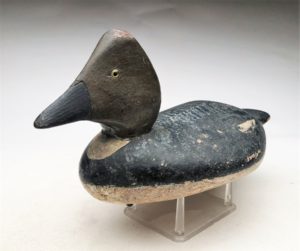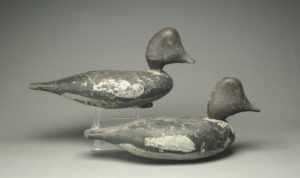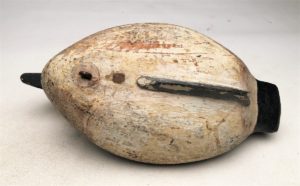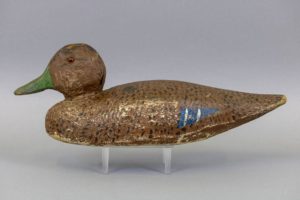A Decoy Corner Article
By Bruce Urben, President
Many of my previous Decoy Corner articles have focused on Wisconsin decoy carvers. As you have seen, there are many, many excellent decoy carvers who lived and hunted in the Badger State. There is no question that I have a soft spot in my collection for Wisconsin carvers!
While I occasionally shift gears and recognize some other vintage decoy carvers in other states, I recently had the opportunity to research a decoy carver from Vermont. First, Vermont is not a hotbed of well known and respected decoy carvers; maybe three or four have come from this area. I was recently commissioned to carve a pair of goldeneye decoys in the contemporary antique style of George H. Bacon. Before starting any contemporary antique replica, I do diligence to research the carver, his style, attitude, design and paint pattern to pay homage to his heritage. In completing this research, I thought it might be interesting for you to hear a little about one of the great carvers from the Maple Syrup State!
George H. Bacon was born in 1861 in Burlington, Vermont. Many consider George to be one of the most collectible and valued of all Vermont carvers.
As an adult, George was employed by the Blodgett Oven Co. of Burlington, Vermont. He was an avid waterfowler and fisherman, and plied his hobby on Lake Champlain near the Vermont border. As a market hunter, he was also busy carving his own decoys, as large spreads were necessary to lure ducks. He was also employed during the duck season as a guide on Lake Champlain and routinely guided many of the officers and directors of the Oven Company. His carving expertise improved to the point that he sold his decoys locally and to many of the “sports” he guided.
It has been written that that Bacon’s simple smooth style and paint, his characteristic wedge shaped heads with rounded puffy cheeks, small glass eyes and tear drop weight and leather anchor loop identified his decoys. Very few were branded or signed by the carver! It is also documented that Bacon’s style had influenced William J. Mason in his factory production in Detroit, Michigan in the 1890’s. Many have confirmed that Bacon used a course whisk brush to apply featheration on the decoy’s backs.
Bacon produced many species of waterfowl but his greatest production was diver species, because that is what he typically hunted. It has been reported that his Goldeneye decoys are some of his best work!
Very few decoy carvers are represented at the Shelburne Museum in Shelburne, Vermont, but George Bacon’s decoys are proudly displayed there along with the east coast carvers of Lincoln, Ward and Crowell. Author Lloyd Harrell lists George Bacon as one of the top 100 greatest carvers in America!
George Bacon passed away in 1925 at the age of 64 in Burlington, Vermont.
George’s decoys are held in high regard by collectors. Good examples of his diver ducks have sold at auction from several hundred to well in the thousands of dollars for pristine examples in original paint.
I knew little of this carver until recently, but his story certainly is an important one in the history of decoy carving in America. Be on the lookout for a Mason looking decoy with puffy cheeks and smooth simple paint; it just might be a George Bacon, Vermont original!




